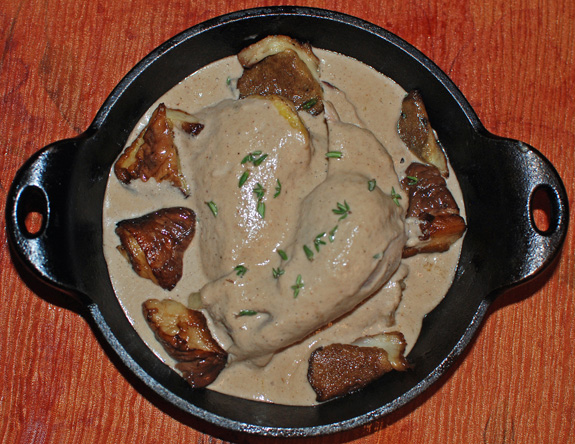Satsivi is a thick Georgian sauce made with walnuts, onions and spices. There are many Georgian nut sauces, but this is the most famous. The sauce is served with poultry — especially turkey — or sometimes with fish. Although this is traditionally a cold dish (tsivi means cold in Georgian), I prefer to serve it warm. I choose guinea hen because it produces a moister and more flavorful meat than chicken or turkey. It goes particularly well with wild mushrooms like porcini.
This recipe is as much about satsivi as it is about the best way to cook poultry. Although the process I describe below is time-consuming, it gives outstanding results. The brine guarantees that the meat is salted throughout, which accentuates its flavor. And because poultry legs and breasts do not cook at the same temperature, I prepare them separately instead of cooking the whole bird and ending up with undercooked legs or a dry breast.
Guinea hen sous-vide
Yields 4 servings
1 guinea hen, 2 1/2 to 3 lb
kosher salt
4 oz butter, sliced
2 tsp chopped fresh herbs (thyme, rosemary, parsley, basil…)
- Place the guinea hen in a pot. Cover with a brine made of cold water blended with 7% salt, and refrigerate for 6 hours.
- Discard the brine and soak the guinea hen in fresh cold water for 1 hour, changing the water every 15 minutes.
- Remove the guinea hen from the pot. Separate the wings and legs. Break the carcass lengthwise to obtain one piece with the breast on the bone, and one back piece. Reserve the breast on the bone, and the legs. The other pieces (wings, back, neck) can be used to make stock.
- Place the legs and half of the butter and chopped herbs in a sous-vide pouch. Cook in a 166 F water bath for 8 hours.
- Place the breast in another sous-vide pouch with the rest of the butter and chopped herbs (if you don’t have a pouch large enough, remove the bone). Cook in a 146 F water bath for 2 hours.
Guinea hen satsivi
Yields 4 servings
guinea hen sous-vide
3/4 oz butter
2 1/2 oz onion, thinly sliced
1 large garlic clove, thinly sliced
1/8 tsp ground star anise
1/8 tsp ground black pepper
1/4 tsp garam masala
3 stems saffron
2 tbsp red wine
3 oz walnut halves
2 oz ice cubes
2 oz heavy cream
- Take out 6 oz of liquid from the guinea hen sous-vide pouches. Keep the pouches warm.
- Melt the butter in a saucepan over medium heat. Add the onions and garlic, and cook until golden brown. Add the star anise, black pepper, garam masala, saffron, and red wine, and stir for 1 minute. Add the walnuts and the liquid from the guinea hen, bring to a boil, cover with a lid and simmer over low heat for 20 minutes. Let cool for a few minutes.
- Transfer to a blender, add the ice cubes and heavy cream, and process until smooth.
- Return to the saucepan, cover and keep warm.
- Take the legs and breast out of the pouches. You can either discard the skin or cook the meat skin side down in a very hot pan with olive oil until brown and crispy. Cover with the sauce and serve.


3 comments
[…] satsivi, a cold dish of chicken in walnut sauce, tasted more like one of those supermarket spice-and-salt […]
This recipe doesn´t seem too traditional to me. I´ve been to Georgia recently and the satsivi I ate there didn´t have star anis or garam masala. The saffron they use is not actually real saffron, it´s marigold petals that imports almost no flavor to the dish but gives it a lot of colour. The traditional spice blend for any georgian dish is made of fenugreek, coriander seed and marigold, plus some extra herbs and spices to give it some character. In the case of satsivi, I´ve seen recipes using cinamon. Dill and tarragon also comes in big time. Instead of red wine, vinegar is used. I don´t mean your recipe is bad or wrong, it just doesn´t seem like the real thing.
Hi Eduardo, you’re right, this is absolutely not a traditional satsivi. Most recipes on my blog are not traditional at all, and my more recent posts tend to give more explanations about the changes I make and my motivation.